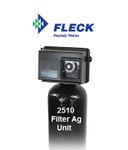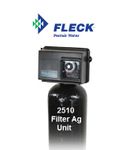Since 2004 Glass Water Systems has been a leader in Economical Water Treatment. Residential, Commercial, and Industrial Water Treatment Products. BEST PRICES GAURANTEED
Filter AgŪ Suspended Solids / Sediment Filter Down to 20 microns

INSTALLATIONS STARTING AT $100.00 * NEXT DAY INVENTORY * WE BEAT ALL ESTIMATES BY UP TO 10%
CONTACT INFORMATION:
TOLL FREE: 1-877-345-2770 LOCAL TAMPA: 813-832-9293 813-626-9498 EMERGENCY #: 813-244-5185 FAX: 813-620-0174 EMAIL: glasswatersystems@msn.com glasswatersystems@yahoo.com
PHYSICAL ADDRESS: 9402 US 92 #106 TAMPA FLORIDA 33610 (RIGHT NEXT TO STEPPS TOWING IN THE EASY AC BUILDING COMPLEX ON EUREKA SPRINGS ROAD)
Clack Filter-AgŪ has many outstanding advantages over the more common granular filter media used for suspended solids reduction. Its fractured edges and irregular surface provides a high surface area and complex flow path for efficient removal of suspended matter through out the filter bed, typically reducing suspended solids down to the 20-40 micron range. The larger particle size creates less pressure loss through the filter and allows deeper sediment penetration into the bed for higher sediment loading and longer filter runs. This large and irregular shape prevents the screening and caking of sediment in the top several inches of the filter bed as happens in the typical sand filter, thus preventing a rapid build up of head loss and blinding problems. Filter-AgŪs light weight means lower backwash rates and better bed expansion to release trapped sediment and rinse the filter media during the backwash cycle. This ideal combination of particle shape, size and density make it a good choice where quality water filtration and water conservation are important. Although not intended to be an iron reduction media, extensive field experience has shown Filter-AgŪs rough and jagged surface to be very good at entrapping the fragile iron flock that forms after dissolved iron has been oxidized. The fragmented edges are apparently good flock collection points for the precipitated iron. Typical oxidation methods include aeration, ozonation and chlorination. Substantial savings can be realized when designing a system using Clack Filter-AgŪ. Its low pressure drop, high service flow rates and high bed loadings combined with lower backwash rates allow economy in equipment downsizing and reduced pumping requirements. Its light apparent density also saves on handling expense and shipping costs. Filter-AgŪ can be applied to systems designed for either pressure or gravity flow. Because of its unique density, Filter-AgŪ can also be used in multi-media (graded density) filter designs allowing a more flexible approach to difficult filtration problems.
Advantages: There is less pressure loss through a bed of Filter-AgŪ than through most other fi lter media Light weight requires lower back-wash rates than those required for other fi lter media High service rates result in lower equipment costs and a savings in space High sediment reduction capacity results in longer fi lter runs, with a substantial savings in backwash water and time out of service Reduced shipping cost due to light weight/cu. ft. Replacement of sand with Filter-AgŪ in existing installations may increase fi lter capacity 100% or more. Caution should be taken upon start-up that the lightweight Filter- AgŪ is not washed to drain
Physical Properties: Color ................Light grey to near white
Bulk Density .........24-26 lbs./cu. ft.
Specific Gravity .....2.25 gm/cc
Mesh Size ............12 x 30
Effective Size .......0.67 mm
Uniform Coefficent....1.8
Hardness ............ 6 (Mohs scale
Conditions for Operation:
Water pH range .........wide range
Maximum water temperature .............140°F/60°C
Bed depth .............. 24-36 in.
Freeboard ...............50% of bed depth (min.)
Service flow rate ......5 gpm/sq. ft., although considerably higher rates are often used
Backwash flow rate ................8-10 gpm/sq. ft.
Backwash bed expansion .............20-40% of bed depth Upon installation allow bed to soak overnight before backwashing




